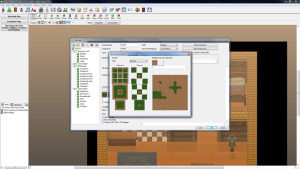No Man’s Sky Pre-Orders Open for a June Release
Posted by Rampant Coyote on March 3, 2016
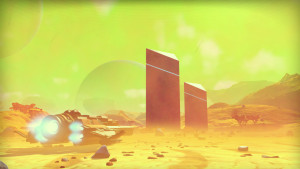 It seems early for pre-orders, but the giant procedural space game No Man’s Sky is finally scheduled for release, and is available for pre-order from their site / Humble store, from GOG.COM and from Steam. It will also be available for the PS4.
It seems early for pre-orders, but the giant procedural space game No Man’s Sky is finally scheduled for release, and is available for pre-order from their site / Humble store, from GOG.COM and from Steam. It will also be available for the PS4.
I’m trying not to be too excited for this game. After all, procedurally generated space epics have been around as long as Elite. I have no idea how it will play. It looks like they’ve gone over-the-top with the procedural generation. But the one thing that convinced me is a comment in this talk from GDC last year. Art Director Grant Duncan talks about trying to make the look of the game emulate the science fiction art of the 70s and earlier… pretty much pre-Star Wars… the amazing art of Chris Foss and others. The kind of thing that was on vintage book and magazine covers of the science fiction stories I read when I was younger. (And yes, this was AFTER Star Wars, but I was reading older books).
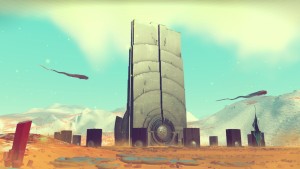 Looking at some of the screenshots, I’d say they succeeded. If the usual game experience is anything like this, it will be a visual treat even if it plays like crap. I know, that sentence makes the hardcore designer in me cringe. But one of my childhood influences was a fantastic art book by Stewart Cowley – the Terran Trade Authority Handbook of Spacecraft from 2000 to 2100. The art was so evocative and transporting. Seriously, seriously amazing stuff. I couldn’t help but be transported and become a sci-fi geek. To this day, I still wonder about those weird alien cities that would move from giant pedestal to giant pedestal on… was it Alpha Centauri?
Looking at some of the screenshots, I’d say they succeeded. If the usual game experience is anything like this, it will be a visual treat even if it plays like crap. I know, that sentence makes the hardcore designer in me cringe. But one of my childhood influences was a fantastic art book by Stewart Cowley – the Terran Trade Authority Handbook of Spacecraft from 2000 to 2100. The art was so evocative and transporting. Seriously, seriously amazing stuff. I couldn’t help but be transported and become a sci-fi geek. To this day, I still wonder about those weird alien cities that would move from giant pedestal to giant pedestal on… was it Alpha Centauri?
 So maybe there’s part of me hoping this game will help transport me back to my childhood frame of reference. It certainly looks like it. From the videos, its a practically infinite (18 quintillion planet – millions of players will eventually put a dent in that but will still never fully explore it) procedural galaxy teeming with life and ancient artifacts and colorful space. It’s the fantastic space exploration of imagination from the early to mid 20th century. The kind that Star Wars originally tapped into and drew inspiration from.
So maybe there’s part of me hoping this game will help transport me back to my childhood frame of reference. It certainly looks like it. From the videos, its a practically infinite (18 quintillion planet – millions of players will eventually put a dent in that but will still never fully explore it) procedural galaxy teeming with life and ancient artifacts and colorful space. It’s the fantastic space exploration of imagination from the early to mid 20th century. The kind that Star Wars originally tapped into and drew inspiration from.
It’s a game where you can planet-hop within minutes (seconds?), land your ship almost anywhere, hop out, and explore. Find resources. I don’t know about ‘crafting,’ but there’s definitely a trading element. There’s space combat. There’s a form of leveling up, at least so far as improving your space ship and your space suit (very important, with some toxic environments!).
I know I may be setting myself up for disappointment. The hype has been strong for this little indie-made game for a long time, and I don’t know that there’s anything that could live up to all that. Nothing can be that good. But it may prove to be good enough. I want to believe.
I’m crossing my fingers here, ladies and gents. I guess we’ll find out for sure in a little over three months.
Filed Under: Game Announcements - Comments: 2 Comments to Read
Frayed Knights 2 – The Story Begins!
Posted by Rampant Coyote on March 2, 2016
Our focus lately has been so heavy on level design that it’s hard for me to think about anything else to discuss about the game. I’m really, really excited about how this is working out, and I’m excited for you guys to play them. But… I don’t want to cross from “teaser” into “spoiler” territory. However, be warned: there will be some references to the events of the first game here, so if you are still pushing for victory in The Skull of S’makh-Daon and wish to be unsullied, don’t read past the WARNING notice a few paragraphs down.
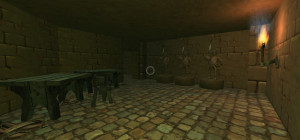 In Frayed Knights 2: The Khan of Wrath, we’re trying to improve everything about the original game. Story is a big one. While I feel I did an okay job on the first game, I really wanted to punch it up more for the second game. In addition to a more gripping and coherent story arc, I also want each of the 20 dungeon levels to feel like a self-contained story in their own right. Sort of like a TV series with each dungeon level acting like an episode. Self-contained, but moving the overall arc along.
In Frayed Knights 2: The Khan of Wrath, we’re trying to improve everything about the original game. Story is a big one. While I feel I did an okay job on the first game, I really wanted to punch it up more for the second game. In addition to a more gripping and coherent story arc, I also want each of the 20 dungeon levels to feel like a self-contained story in their own right. Sort of like a TV series with each dungeon level acting like an episode. Self-contained, but moving the overall arc along.
So every area has its own history and back-story, as well a story that evolves while the adventurers tackle it. I’ve had a lot of fun working on the back-story of each dungeon, and the characters and personalities involved before the player ever arrives on the scene. A lot of this work won’t really ever be visible on the surface: as a player, you might only see a fraction of this. But it informs the level design, the lore, some of the narrative elements, what kinds of encounters you’ll face, etc.
So why are the Frayed Knights here?
WARNING: Minor spoilers for the first game, Frayed Knights: The Skull of S’makh-Daon, starting now.
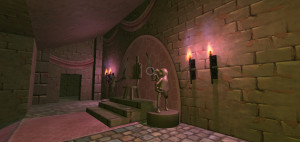 Fear grows throughout the kingdom of the return of the arch-lich Nepharides, the villain of the Wizard War that nearly destroyed civilization just a few centuries ago. Scholars have uncovered a prophecy about his return, and signs of its imminent fulfillment are already appearing. The kingdom is trying to keep this information quiet and root out the problem, but it is growing desperate.
Fear grows throughout the kingdom of the return of the arch-lich Nepharides, the villain of the Wizard War that nearly destroyed civilization just a few centuries ago. Scholars have uncovered a prophecy about his return, and signs of its imminent fulfillment are already appearing. The kingdom is trying to keep this information quiet and root out the problem, but it is growing desperate.
Meanwhile, the Adventurer’s Guild is faring little better. Its membership delves into the ruins of the old civilization and the hidden places that are on the forefront of many of these prophetic signs, and mortality rates have skyrocketed. Worse, a secret faction within the Guild has apparently sided with the forces of evil, and work to assist in Nepharide’s return.
While the Frayed Knights revealed one of the major conspirators, the Guild hasn’t fully rooted out this faction, and there are some within the Guild who would like nothing more than to see the Knights – and their rivals / allies the Heroes of Bastionne – die in lingering agony for what they’ve done. Not only has this prevented both groups from obtaining membership in the guild, but they’ve been counseled by none other than the guildmaster himself, Argus Stormhammer, to lay low for a while until the full conspiracy and those who would betray them are uncovered.
So… while these frightful events and turmoil at the highest levels are taking place, and the kingdom is frantically sending soldiers to prevent the prophecy before it is too late… the Frayed Knights are cooling their heels in the middle of frickin’ nowhere, in a community called Roark’s Roost. Adventuring opportunities are few and far between, and they get to share this annoying “vacation” with the Heroes of Bastionne.
At least the inn is cheap. And if the world ends tomorrow, Dirk won’t have to worry about settling up his bar tab.
Filed Under: Frayed Knights - Comments: Comments are off for this article
Amaranth Games Retires From Game Development – For Now
Posted by Rampant Coyote on March 1, 2016
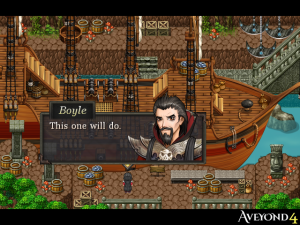 Well, ya’ll know I’ve been a fan of Amanda Fitch and Amaranth Games since the release of the original Aveyond: Ren’s Quest (then just called Aveyond). It was one of the first commercial releases of an RPGMaker-based game, and even if was the first of the open floodgates, the series remained among the highest quality RPG Maker titles on the market.
Well, ya’ll know I’ve been a fan of Amanda Fitch and Amaranth Games since the release of the original Aveyond: Ren’s Quest (then just called Aveyond). It was one of the first commercial releases of an RPGMaker-based game, and even if was the first of the open floodgates, the series remained among the highest quality RPG Maker titles on the market.
For a while, Amaranth continued to capitalize on the casual games market, with the RPGs selling well to that market as well as the RPG fans. Amaranth interspersed some straight-up casual game releases between RPG launches for a while, mainly because they were far, far easier to make, RPGMaker notwithstanding. The market kept shifting, and Amaranth kept adapting, breaking the third game into four ‘chapters’ that were theoretically smaller than the first two games, selling for half the price. But of course, the games grew…
Last month, the fourth (or seventh, depending on how you count) Aveyond game launched… Aveyond 4: Shadow of the Mist.
And, sadly, it sounds like it may be the last.
Yesterday, Amaranth Games posted that it is changing its name to Aveyond Studios, the website is going to become a personal company website rather than a games portal, and they will be pursuing tools development. While they aren’t completely writing off the possibility of another Aveyond at some point, at this point the market is no longer interested and they cannot continue game development. On a personal level, it sounds like they … and they meaning Amanda & Bryce, these indie studios really are just very small collections of people… are anxious for a break from the pressures of game development: “The game industry is very competitive right now and we need a break from the madness.”
A larger excerpt from the post:
“We love making Aveyond, but Aveyond 4 will likely be the last game in the series. In the beginning, Aveyond was a hit. It generated around $500,000 USD in sales. As the years have gone by, the Aveyond games have made less and less. Our last game, in my opinion, was awesome, but sales were the lowest in the series and only made around $30,000. It’s not enough for one, let alone two developers to live on. A lot has changed over the years in games and what the general market wants has shifted. It’s just the way things are. If you REALLY want another Aveyond game, I’ll create a Kickstarter campaign. If it works, great. If not, then that’s just the way things are.”
Now, I totally understand and I wish them the best of luck. I think they are making the right decision for their family. As stated, it’s the way things are. I’m a bit sad for me, personally, as I’ve enjoyed the Aveyond series.
More particularly, I’ve held up Amaranth Games for years as an example of indie success, and it’s been an inspiration for me. Amanda did it right. Now, this shifting of gears and retirement (for now) from game development in no way changes that. While perhaps not as “rah, rah!” inspirational, I think this current move might be yet another good example of doing things The Right Way. Especially when game development has become a burden or not the right thing right now for one’s family / stage in life.
So while it may no longer be contemporary, Amaranth Games remains a great example of doing it right:
- Learning the ropes with non-commercial efforts.
- Seizing an opportunity when the market presents itself
- Excelling within a niche and growing beyond it
- Adapting to changing market conditions
- When it’s no longer fun or profitable, getting out cleanly BEFORE it becomes a disaster
So… Amaranth Games… Amanda & Bryce: I salute you and wish you well and good luck in your new venture. I also want to thank you for the many hours of enjoyment in the cute, quirky, sometimes disturbing but always delightful world of Aveyond.
Filed Under: Biz, Indie Evangelism - Comments: Read the First Comment
Becoming an Indie is easy. Success is what’s hard.
Posted by Rampant Coyote on February 29, 2016
An article at Gamasutra last week proposed 10 easy, one-liner steps to becoming an indie game developer. It was instantly met with criticism, and some arguably better articles appeared correcting the deficiencies. But while the original author made it sound like a more generalized blueprint to “going indie,” it really just outlined the straightforward approach that he’d taken, with the Unreal engine.
The real general advice for aspiring indies is the same as the advice for aspiring writers or musicians or anyone else wishing to take the plunge in a creative field: Choose your tools, get started, learn / take lessons, and practice, and don’t expect to receive immediate success for your first endeavors. And also assume that “success” is going to be a concept that will require constant redefinition.
The challenge with aspiring indie game developers is that there are a dizzying array of choices that need to be made up front, things like what will your development platform will be, what gaming platform will you target, what tools will you use, what kinds of games will you make, how will you distribute them, etc.
My “simple” suggestions would be:
#1 – Use what you’ve got. You probably already have a computer , so make that both your development platform (the machine you’ll make games with) and your target platform (the machine that will play the games). One option is to make web-based games, which solves both the target platform problem (many different machines can run it), and the distribution problem.
#2 – Use tools that are an optimum (for you) combination of inexpensive, beginner-friendly, and well-supported. The price may be free (as inexpensive as you can get), but if it is poorly supported, bugs won’t get fixed, the documentation is sub-par, and there’s little community to offer you help, you are just going to be frustrated. And if you are just starting out and you jump into something too challenging to use, you are going to get frustrated early. This may involve some research.
#3 – Start simple. I’d recommend starting with 2D games instead of 3D. In the end, they both have their own challenges, but 2D is easier to get your head around. When you get past the training and start making your own stuff, start with the simplest gaming concepts you can, and then expand. I’m a big advocate of making your own version of Pong to start.
#4 – Get training. You’ll probably need some before you even choose your tools, just to learn how they work and what they can do. These days, a lot can be obtained online for free. YouTube tutorials for the win. But yes, follow tutorials. It may seem frustrating painting by numbers to make a duplicate of someone else’s dirt-simple game, but it’s worthwhile if you are just learning. There are also books available (many digitally) and even some not-too-expensive courses for training you can sign up for. This is valuable even for the seasoned vets, because there’s always more to learn.
#5 – Game Jams provide a really cool opportunity to take a break from your current projects and get some quality, intensive practice… and to practice *finishing*.
#6 – CREATE. Create lots. And while maybe your first efforts end up so bad that they aren’t worth finishing, definitely practice finishing a game and distributing it – if only to people who are friends of yours.
#7 – Have reasonable expectations. Your first efforts will probably not be marketable. Game development is a skill as much as it is a process. Or, really, a ton of skills. Your first complete game might not be worthy of public distribution. With each project, increase your goals. Learn what you can do better and try to achieve that. Keep improving in whatever areas need the most work. Didn’t finish the game last time? Finish it this time. Took too long on the last one? See if you can speed your development time on this one. Only sold 15 copies last time? Aim for at least 150 this time. Reviews averaged only 2.5 out of 5 last time? Aim for higher quality to get at least a 3.5 this time.
While these suggestions are simple, the implementation is not. Making a game – even a game jam release – is challenging. There’s really no other substitute than rolling up your sleeves and getting the experience.
Filed Under: Game Development - Comments: 2 Comments to Read
The Return of Master of Orion
Posted by Rampant Coyote on February 26, 2016
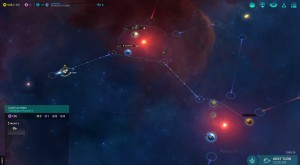 I normally don’t play “Early Access” games, on the justification that I don’t have time to play the completed, released games I already own, so why would I want to play a buggy, incomplete game?
I normally don’t play “Early Access” games, on the justification that I don’t have time to play the completed, released games I already own, so why would I want to play a buggy, incomplete game?
But I make exceptions. And for the early access launch of Master of Orion, the rebooting of a franchise I spent an embarrassing amount of time playing back in the 90s, I was happy to make the exception. It was just over an hour, but it felt like time well spent. Except there’s a very real danger here that it could turn into a gigantic time-sink, like its predecessors.
The early access game seems very playable thus far. A few options are missing, like a tutorial game, some customizations, or the ability to change difficulty levels. However, the game has built-in tutorial pop-ups whenever you encounter a new situation, so it was surprisingly easy to pick up the basics. While I’m undoubtedly missing out on a lot of subtleties and optimizations necessary to play a competitive game, my Psilons seemed to be expanding and destroying space pirates quite nicely.
The developers seem to have cribbed a few pages from Civilization V to streamline the interface and the gameplay. Compared to how I remember the older games, this one plays far easier and more quickly. If it weren’t for the linearly increasing complexity that comes with managing multiple colonies, I’d say it feels a little bit like a board game. A board game voiced by celebrity actors, maybe.
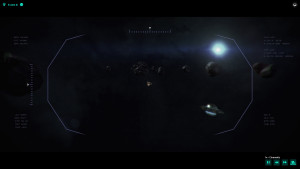
Many Master of Orion fans will be disappointed by the lack of tactical combat in space. I know I was. UPDATE: Master of Orion does offer an RTS-style tactical combat option, but it is disabled by default. For me, the tactical combat was the differentiation between the also-excellent Galactic Civilizations series and Master of Orion.
There are a lot of 4x (Explore, Expand, Exploit, Exterminate) space games out there nowadays. Master of Orion used to rule the roost in that respect. Now, I personally think the king of the hill is still Galactic Civilizations II. I haven’t quite warmed up to the sequel yet, which feels like a streamlined revision rather than a new game. Considering the depth and the complexity of Gal Civ II, and the fact that Gal Civ III is multiplayer, some streamlining was probably in order. I’ve played a couple of the other indie 4x space games, and they are respectable, each with their quirks. Some even offer tactical ship combat…
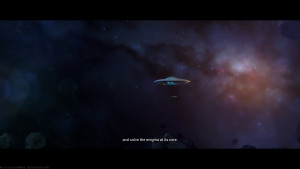 Besides the tactical ship combat, the “secret sauce” for Master of Orion, at least as well as I recall it, would be the races, the existence of the super-Gaia planet Orion protected by an ancient, automated robot space guardian, and movement limitations based on warp connections between systems (bypassed eventually by technology). So far, all of these other elements seem to be intact. So in those other respects, it feels like the original franchise.
Besides the tactical ship combat, the “secret sauce” for Master of Orion, at least as well as I recall it, would be the races, the existence of the super-Gaia planet Orion protected by an ancient, automated robot space guardian, and movement limitations based on warp connections between systems (bypassed eventually by technology). So far, all of these other elements seem to be intact. So in those other respects, it feels like the original franchise.
From just my short experience playing it, it looks like the Master of Orion reboot is shooting for the simpler, more streamlined tier of the 4x jungle… which is surprising given its legacy. However, it also looks like it is emphasizing multiplayer, which makes that focus pretty critical. It may end up being king of the multiplayer 4x space strategy games.
If so, that’s not a bad niche to own.
I’m excited to see this game evolve to final release.
Filed Under: Impressions, Strategy Games - Comments: 2 Comments to Read
Burn Your Ships vs. Don’t Quit Your Day Job
Posted by Rampant Coyote on February 25, 2016
When I was first discovering the “indie” side of game development and entrepreneurship… and I see the same in writing … I was confronted with two seemingly contradictory pieces of advice:
BURN YOUR SHIPS! (BYS)
In reference to conquistador Hernando Cortez, who burned his ships and his only avenue of escape. The only way back was forward. The idea here is that if you want to succeed, you need to make success your only option. Cut the safety rope, quit the day job, focus on the goal, and put every ounce of energy into it. The fear of starvation will help you succeed, but more importantly you will be completely committed to the task.
DON’T QUIT YOUR DAY JOB! (DQYDJ)
The more pragmatic approach recognizes that success, particularly in the field of entertainment, tends to come as a result of tenacious persistence meeting one or more lucky breaks. There are too many external forces at play, and this business tends to crush those that demand success comes suddenly and on their schedule. Keep the day job, and build upon a series of base hits with the occasional home run until it is no longer necessary.
Which Approach Works Best?
While it’s purely anecdotal and may be driven by my own biases, but most of the people I have investigated and in some cases gotten to know who have been successful and stayed successful over the long term embrace the second approach – DQYDJ. And I’ve known several people who have tried the BYS approach and been crushed by it, and a handful who met some success with the first approach but then faded into obscurity and went on to do something else after all.
However – I also know far more people who have followed that second approach and – like me – have never turned it into real, quantifiable success. Yet. And while it’s all well and good to suggest that it’s not failure if you’ve not quit trying to succeed, the truth is we all only have a finite period of time to make it work. Life – and eventually death – will happen no matter our intentions and muck up even the best-laid plans.
Can You Do Both?
Looking past the contradictions and focusing on the core message of both “approaches,” I find that many of the successful people I know or know of actually practice the roots of both.
The core idea of the “Burn your ships!” approach is that of commitment, and an intense focus and drive to meet short-term goals. While it advocates dispensing completely with any kind of Plan B, the heart of the advice is about not allowing yourself to become comfortable with a Plan B, or to allow it to become an acceptable alternative and thereby reducing your commitment.
The “Don’t quit your day job” advice is pragmatic, longer-term advice. The heart of it is a combination of persistence over time and allowing success to come gradually over time with a gradual(ish) weaning-away from safety and alternatives, and a recognition that this also gives you some freedom to course-correct and make improvements to your goal.
I think both are important. Without commitment and a major drive for short-term goals, there is little long-term progress. “Don’t quit your day job” becomes “never quit your day job.” Meanwhile, the path to success is littered with the figurative bodies of those who ran out of time and / or money short of their goal, in spite of their bold intentions and their leaping off the starting line in an amazing sprint.
I don’t know if the true BYS-advocates would accept the idea of limited ship-burning, but it makes intuitive sense that short-term goals should be motivated with short-term risks or rewards, rather than risking long-term livelihood. Will that work? Can you get something close to a BYS-level of motivation and drive – or something close to it – without risking devastating long-term hardship?
At LTUE this year, one author talked about how she and her friends created a combination of big (but short-term) rewards and penalties for themselves to motivate them to achieve the goal of writing a book in three days. She said that in the end, those external motivations proved to be unnecessary, and she no longer needs them. They might help to make the commitment in the first place, but in the end, the commitment is intrinsic. Although she’s achieved some not-insignificant success, so in a way… her ships were burned for her. She can’t lose the momentum now.
So I don’t know. Hunger and fear can be powerful motivators, particularly in the short term, but I don’t think those are the only ways to cultivate a drive, particularly ones that lead to longer-term sustainability. I can’t say this with absolute surety, as my own first-hand experience in this respect is hit-or-miss. But it’s something to consider… can we achieve a balance here?
Filed Under: Indie Evangelism - Comments: 5 Comments to Read
The Finiteness* of Time
Posted by Rampant Coyote on February 24, 2016
When I was in elementary school, summers seemed to last forever. In junior high, there was plenty of time in the afternoon to do just about everything… except maybe all my homework. That perception really does go away as an adult. Things seem to move faster.
As a guy trying to pack in family, game development, writing, and occasionally reading, practicing guitar, and game-playing into his evenings, I can say that time passes by in a blink these days.
One of the challenges of estimating time is that when I’m “in the zone,” time compresses by a factor as much as 4:1. I think that only 15-30 minutes have gone by, and check the clock to realize it’s been over an hour and a half. This makes time estimates difficult later – I think, “Oh, task X only takes 15-30 minutes. I’ve got three hours. I’ll whip that out and do five other tasks just like it tonight.”
Yeah… no. That just ends in frustration. Potentially tears.
I guess I’ve hit that wall a little too often over the last few months. Maybe it’s that attitude from childhood that there’s always plenty of time, and I certainly know that I’m not the most efficient time manager in the world. So I always think there are more hours I can find here and there, and that I can always go faster if I need to. And of course, when you are young enough, the rest of your life seems almost infinite.
But when you are being efficient, you can’t go much faster, and you realize that even if you live to be over a hundred you aren’t going to be able to move a large fraction of the ideas out of your head and into reality, then it’s kind of a stark realization. I’m coming to grips with it a bit more now. It’s a wake-up call to make the most of the time I do have. I still spend a lot of time on activities that are neither important nor all that enjoyable… just sort of idle distractions. So what’s the point?
* I had to look it up – “finiteness” is actually a word. Take THAT, spell-checker! Although “finity” might work, too.
Filed Under: Geek Life - Comments: 7 Comments to Read
RPG Design: There’s a Reaper in the Basement
Posted by Rampant Coyote on February 23, 2016
 Lord British has a very powerful Reaper in his basement in Ultima Underworld II: Labyrinth of Souls. This is a problem. But maybe not in the way you expect.
Lord British has a very powerful Reaper in his basement in Ultima Underworld II: Labyrinth of Souls. This is a problem. But maybe not in the way you expect.
It’s extremely hard to defeat, but not impossible. Therein lies the rub. If it was “level appropriate,” it would be just another combat encounter. If it was clearly impossible, players would have known better than to try and take it on, and would have quickly pursued other measures to get the treasure it guards.
But instead, through the miracle of saving and reloading, that desperately improbable fight becomes merely… unfair and frustrating. That slim chance becomes a matter of patience.
That’s how we play today. Honestly, that’s how I played it back in 1993. My impression was, “Wow, they decided to make this game really hard, huh?” Many other players had an even worse reaction, along the lines of “those stupid developers don’t know how to balance this game!”
But no, the whole point was to encourage you to try a non-combat solution. To encourage you to be clever. Eventually, Looking Glass got it right, with the Thief series, but they did it by constraining the environment and the tools. Even when you were doing exactly what the developers expected you to do, you felt like you were cheating. But in a more open-ended RPG, this is still a problem.
I think more options and multiple solutions to a challenge are more than just a good thing in most RPGs. While I accept the nature of the computer-controlled RPG universe, I’d also argue the ability to apply many different approaches to a challenge is part of the heart of the RPG experience – having real choices. So how can we make something like this work?
Now, I could lay the blame on the ease of saving and restoring, but that’s only a small part of it. Ultimately, the player has to be made aware of three things:
#1 – That a direct confrontation is undesirable.
#2 – That alternatives exist
#3 – That choosing alternatives will not be punished
The first one can be done directly, through something like a stats or “conning” to let the player know immediately if they are outclassed or not. It can also be done via suggestion, either through lore or seeing another character get horribly defeated by the beast. However, since the whole idea of a heroic RPG is playing a character who is an exception and who succeeds where others fail, that may be not be enough. Another issue is that in an RPG, the player character’s power level is dynamic, and so it’s never really clear if he may be “tough enough” to take on a particular challenge until too late. It can also be done by letting the player try and fail, but that really just trains them to save more frequently.
In the second requirement, this is also an instruction thing. This can be done by some kind of tutorial-like suggestion, or (better) by the player witnessing the alternatives being exercised by other characters. Or maybe there’s a flashback scene that acts like a tutorial. Whatever the case, the player needs to be taught the options that exist in this games’ universe. There are too many games where that isn’t an option for this to be assumed.
In the third requirement, “punished” means the player won’t miss out on rewards available from combat (mainly experience points). This can be either by rewarding the player equally no matter how he or she resolves a challenge, or by leaving an implied promise that the player can always come back later when more powerful and finish the monster off for full credit. The game system has to make good on these promises though – the rewards have to be equal. And there can’t be any kind of “bonus” for defeating much-harder opponents. That just encourages players to brute-force their way through the hardest encounters.
Whichever options are applied, it’s not an easy thing… even with today’s computers where you aren’t worried about running into the memory limits of 640k low memory.
Filed Under: Design - Comments: 2 Comments to Read
Book Impressions: The Aeronaut’s Windlass
Posted by Rampant Coyote on February 22, 2016
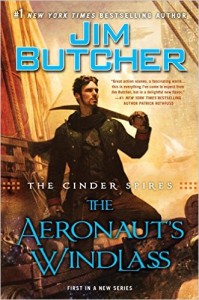 It took me a long time to get started on the Harry Dresden series, by Jim Butcher. Everyone was talking about it, but I thought I’d be smart and wait until the series was further along before starting. Then, you know, I wouldn’t have to wait so long to get to the next one. In retrospect, that didn’t turn out so well. Yes, the books were as great as everyone said. Yes, I didn’t have to wait for a year for the next one to come out, and I was able to devour one right after the other…
It took me a long time to get started on the Harry Dresden series, by Jim Butcher. Everyone was talking about it, but I thought I’d be smart and wait until the series was further along before starting. Then, you know, I wouldn’t have to wait so long to get to the next one. In retrospect, that didn’t turn out so well. Yes, the books were as great as everyone said. Yes, I didn’t have to wait for a year for the next one to come out, and I was able to devour one right after the other…
… for a while. Then suddenly, I had to face the excruciating wait. And just like everybody else, I had to wait to find out what happens after the shocking ending of Changes. And there are plenty more books to come. So much for my cunning plan.
So I decided not to bother waiting for Jim Butcher’s newest fantasy series, The Cinder Spires. Especially when I heard there’d by airships.
The first book is The Aeronaut’s Windlass. It does have airships… and airship battles! Awesome stuff that sounds a bit like 3D versions of the nautical battles in Alexander Kent’s Bolitho novels. Is it steampunk? Yeah, kinda, although I’d treat it more as fantasy-with-steampunk-leanings. Which is 100% cool – I’d rather have things be original and interesting rather than fitting nicely in a subgenre box. The setting is exciting and intriguing. There are some firearms, crystal-powered energy-blast shooting gauntlets, etheric wizards, talking cats (assuming you speak their language), city-states built on top of colossal towers (the “spires”), and horrifying, deadly monsters covering the surface of the world (and, occasionally, in the clouds).
Obviously, it’s a ripe setting for adventure. The characters – both protagonists and villains – are richly drawn and very exciting. The book cover focuses on Captain Grimm, a disgraced former naval officer now turned privateer, but he’s really only one of an ensemble of characters. It’s hard to single out a “main” character; there are several that would fill the bill. In fact, that might be my biggest complaint of the book: there are perhaps too many points of view. I don’t know what I’d cut, though, so it’s a pretty minor complaint.
The magic system in this world comes at a high cost: the practitioners are universally insane. Or at least appear insane to everyone else, and have trouble dealing with everyday life. Captain Grimm is a bit more used to dealing with these etherealists than some of the others, and has a great quote: “The worst madmen don’t seem odd at all… They appear to be quite calm and rational, in fact. Until the screaming starts.” That accurately describes the principle villain of the story. And that’s all I’m going to say about that, so you can enjoy it yourself.
As usual with Butcher’s works, this is a high-action adventure. You can’t go more than two chapters before something explodes, bad guys (or monsters) burst through the door, or somebody gets captured. Come ready for action. You won’t be disappointed.
My impression: Loved it, can’t wait for the rest of the series.
As an amusing side-note: The cover art for the Dresden series always depicts Harry Dresden with a wide-brimmed hat. In the book, he’s never described as wearing a hat. It’s become something of an inside joke. So for The Cinder Spires, Captain Grimm wears a hat much of the time, particularly when aboard his ship. So naturally, the artist had to portray the captain without a hat on this cover.
Filed Under: Books, Impressions - Comments: Comments are off for this article
Utah Unity Users Group Meeting – Feb 2016
Posted by Rampant Coyote on February 19, 2016
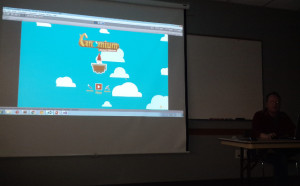 The quarterly meeting of the Utah Unity Users Group Meeting began with the usual Monty Python jokes about the “UUUG” acronym in a classroom at Salt Lake Community College. Then we launched into pizza, networking, and a word from our sponsors. In particular, we heard from KForce Staffing & Solutions, the bringers of the pizza. 🙂
The quarterly meeting of the Utah Unity Users Group Meeting began with the usual Monty Python jokes about the “UUUG” acronym in a classroom at Salt Lake Community College. Then we launched into pizza, networking, and a word from our sponsors. In particular, we heard from KForce Staffing & Solutions, the bringers of the pizza. 🙂
I had a good chance to hang out with old friends, including Mike Rubin. If you are a loooooong-time reader of this blog (from the Blogspot days), you may recall a project Rubin was working on called Vespers 3D. It is still in development, but he’s switching engines over to Unity.
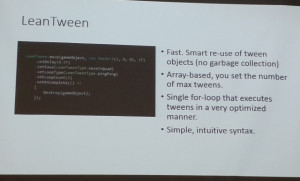 After the opening remarks, Chris Crabtree, developer of Gnomium. He explained several techniques he used in the development of Gnomium. One was tweening, in particular from the LeanTween library. He also showed us how he used these with extension methods, so that Unity GameObjects could gain new functions like “Move()” which took advantage of tweening.
After the opening remarks, Chris Crabtree, developer of Gnomium. He explained several techniques he used in the development of Gnomium. One was tweening, in particular from the LeanTween library. He also showed us how he used these with extension methods, so that Unity GameObjects could gain new functions like “Move()” which took advantage of tweening.
He also explained a technique for spawning off a threaded function in Unity / C#. This is handy in Gnomium (particularly in an experimental new mode he’s working on) to prevent any kind of pauses in gameplay while the game searches for potential word matches in the dictionary.
After this, Josh Jones gave a short presentation on lessons he’s learned about Unity working on tiny but highly varied projects. He shared some of his experiences working with transforms in 3D space, and making calls to web services inside a game.
After these presentations, we continued the informal get-together chatting, showing bits from our projects, and playing around with GearVR. A lot of the discussion of the evening seemed to revolve around VR … at least in developers’ minds, this seems to be The Big Thing.
All-in-all, it was both educational and a great way to connect with folks. Some of it was familiar, but some of the Unity topics were in areas I hadn’t really delved into before. Cool stuff!
Filed Under: Game Development, Programming - Comments: Comments are off for this article
The Game Engine Competition Heats Up
Posted by Rampant Coyote on February 18, 2016
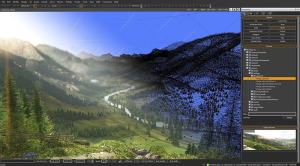 Over the last couple of weeks, the competition for game engines has gotten more interesting. Now, I’ve got zero interest in abandoning Unity at this point. I’m pretty comfortable with it, and it has so far proven to be every bit as powerful as I need it to be. But for those still looking at other options, we’ve got ’em. Besides GameMaker Studio and Unreal, I mean….
Over the last couple of weeks, the competition for game engines has gotten more interesting. Now, I’ve got zero interest in abandoning Unity at this point. I’m pretty comfortable with it, and it has so far proven to be every bit as powerful as I need it to be. But for those still looking at other options, we’ve got ’em. Besides GameMaker Studio and Unreal, I mean….
First off, Amazon has released Lumberyard, a CryEngine-based system that’s tightly integrated with Amazon’s own web services (AWS). It’s currently in beta. The best news is the price. According to the website, “Amazon Lumberyard is free, including full source code, so you can deeply customize Lumberyard for your team and your vision for your project today, and for future projects in years to come. There are no seat fees, subscription fees, or requirements to share revenue. You only pay for the AWS services you choose to use.”
For a AAA-quality engine, this is a pretty decent deal, but the catch is that yes, you have to use their services. If you have a single-player game that doesn’t store information to the cloud, then that’s no big deal. But otherwise… yeah, you are locked in by the terms of that agreement. For some studios that could be a deal-breaker, but it really depends on your needs, budget, and faith in Amazon being your online services provider.
And now, we go from a high-end AAA engine to something on the low-end for beginners. GG Maker may have been around a while, but it’s new to me. I hadn’t heard about it until just a few days ago. This one seems to be aimed more at the GameMaker studio crowd, emphasizing 2D games and an extremely easy, graphically-assisted scripting. It sounds like now that GameMaker has moved from being an educational tool to more of a commercial game development, this tool is trying to fill in the gap for beginners or artists who don’t feel very comfortable with programming yet. As a programmer, I’d be a very poor judge of this… these kinds of tools are more likely to impede me than help me.
Now a tool that would generate custom art for me, that’d be cool… 🙂
The full version is around $70, and advertises support for developing games for Windows, web (HTML 5), and mobile.
So if you are still looking at potential tools to make your dream game,
Filed Under: Game Development - Comments: 2 Comments to Read
Personal Relationships with the Audience
Posted by Rampant Coyote on February 17, 2016
I’ve recently noticed that about half of the video games I play and the books I read are written by people I am personally acquainted with. Maybe not close friends – in some cases they are just people I’m Facebook friends with, or who I’ve exchanged emails or forum posts with, or who I’ve chatted with a few times as conventions. In some cases, they are quite close friends whom I have known for years.
 Now, this is probably not surprising to anybody except myself. After all, I’m in these fields, and that’s who I meet. I remember wondering just how biased I was in liking Vampire the Masquerade: Redemption because a couple of friends of mine that I hung out with at the Game Developers Conference had formed the company that made it. I still maintain that the opening chapter in Prague was one of the most amazingly realized settings and moods in a game ever, especially for the time period.
Now, this is probably not surprising to anybody except myself. After all, I’m in these fields, and that’s who I meet. I remember wondering just how biased I was in liking Vampire the Masquerade: Redemption because a couple of friends of mine that I hung out with at the Game Developers Conference had formed the company that made it. I still maintain that the opening chapter in Prague was one of the most amazingly realized settings and moods in a game ever, especially for the time period.
I think there’s more to it than just being “in the field,” though. With expanded communication and less monolithic industries, the modern era is one in which people are have (and expect) more access and relationships with the artists creating their entertainment. This is no doubt terrifying to some authors who may have pursued the profession specifically to hide in their caves, their own personal fortress of introversion. The J.D. Salingers of the world may face a tougher time of it.
I certainly haven’t restricted myself in any way because of this, but it’s (usually) a nice bonus. There are downsides, of course. Even before reaching the levels of Stephen King’s Misery, there’s a point where customers feel entitled to the artist’s time and attention, to the exclusion of the many, many other fans and friends and… well, time producing. But this is a problem in every industry, not just creative ones. There’s always that one guy…
And then there are times when I love the work, but don’t care so much for the creator, and vice-versa. That’s gotta be okay with people. It is with me – the person behind the work has to be a pretty big douchebag for it to detract from my enjoyment of their work. But then, I generally like people. I know not everyone feels this way, and that can get difficult. And yes, it’s always disappointing when a friend really doesn’t care for your creative work. In my opinion, both of these risks (as a creator) are preferable to being boring.
I guess it can play hell with pen names, too…
But overall, I think the pros greatly outweigh the cons. For one thing, it’s been a great pathway to discovery for me. I’ve found some extremely fun, entertaining works that I might never have stumbled across otherwise because I met someone cool at a con, or came across their blog, or started chatting with them in a forum or on Twitter.
I was also the guy who liked to read the album liner notes and the artist bios and who listened to the commentary track on DVDs. I always wanted to know more about the guys and gals responsible for those things that emotionally or intellectually moved me. Even better than that is to get to know them personally, if only on a very casual, poorly-remembered way. That human connection is big, and it usually enhances the experience for me.
It’s advantageous both ways. Having a real, direct connection back to their audience is HUGE for most artists. Having worked in mainstream games, I remember how hard it was to understand exactly what players were saying, trying to create something for an unknown audience. Sure, there are stages where working in a vacuum can be advantageous, but I feel that the role of the artist / creator is to make something FOR OTHERS. Not everyone feels that way, but the folk I like to hang out with do. It’s a service. It really helps to have a personal connection with your audience and really understand them so you can better serve them.
Filed Under: Biz, Books, Geek Life, Indie Evangelism - Comments: Read the First Comment
Some Thoughts on the Craft of Writing
Posted by Rampant Coyote on February 16, 2016
Back in high school, I thought I was pretty good at writing. I have one surviving example from that era. I used it as reference for an article I wrote for The Escapist several years ago on my first LARP experience (before that was even a term). I winced a lot when I read my old manuscript. It was painful, but it provided me with a lot of details that I had forgotten. When I was younger, I thought it was one of my best writing examples.
My younger self had no clue.
To be honest, from my perspective here in 2016, the article I wrote in 2008 kinda sucked, too. I could do a much better job today, but I don’t think The Escapist wants to pay me to revise it.
I hope that means that I’m growing and improving as a writer. I thought I’d share some thoughts on how this growth happens.
It feels like there are a humongous number of rules / guidelines / techniques for writing a good story. Some are pretty iron-clad and universal (like spelling and grammar rules). Some are pretty loose guidelines and may vary by genre, audience, time, or even our personal process. So guess what? Nobody knows all of these rules, guidelines, and techniques. Any of them can be broken by an author who knows what he or she is doing, but not out of ignorance. Which… is tough, because starting out, ignorance is high, in spite of best efforts.
When a writers are first starting out, they probably don’t know most of these rules. Of the ones they think they know, they have forgotten many of them or don’t think about them while writing, and aren’t sure how to apply many of the rest. And then they allow themselves to violate some others because they think they are special snowflakes for whom exceptions can be made. Eventually this may be true, but beginning writers, in spite of sometimes considerable raw talent, often fall prey to Dunning-Kruger bias.
A new author can find themselves screwing up on accident a lot. They think, “Oh, man, I’d never do that!” and then later discover (or have it pointed out to them) that they managed to do exactly that.
With lots of reading (which trains the brain to recognize certain structures and rules), studying, practice, and maybe formal training, things get better. A lot more of concepts are not only learned, but internalized. That’s a big deal. A writer quits making so many newbie mistakes to begin with, and moves on to a plethora of other mistakes.
And eventually the writer who keeps at it, keeps learning, and keeps growing achieves a state of relative competence. I’m still just aspiring to that. They can crank out a first draft with fewer problems than inexperienced writers have in their final. Their editors may not have to squint so hard to see the gem inside the uncut stone.
Of course, good writing is more than just writing that just follows good structure, obeys guidelines and rules (where appropriate), and employs good technique. That’s all the craftsmanship – the science of writing, I guess. There’s still a huge creative / artistic element as well. I think this can also be trained, or at least learned, but a lot of it is innate as well. But until we get our skills up to that level of competency, it’s like driving a sports car along an unpaved, overgrown, rock-laden dirt road. There’s just nothing there but unused potential.
I think this pattern follows just about every creative endeavor, although for some (like game development) things are a lot less understood, and much more has to be learned the hard way. Since my improvements in writing have been pretty dramatic over the last couple of years, it has been easier for me to see.
I still make plenty of n00b mistakes in game development, too. Maybe one day I’ll be competent there, too.
Filed Under: Books, Writing - Comments: 5 Comments to Read
LTUE 2016 – What I Learned
Posted by Rampant Coyote on February 15, 2016
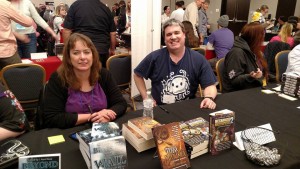 I came home with dozens of pages of notes from Life, the Universe, and Everything. I think I gathered an average of 2 pages of notes from each of the panels, and hit an average of five panels a day, dealing with such topics as: Managing a giant project, marketing on a budget, how to write a novel in three days, roleplaying for writers, hooking your readers, writing military for science fiction, publishing pet peeves, and increasing your writing productivity. I spent most of my time in writing and professional development panels. It would be cool to have more video game development panels next year. Maybe I should sign up.
I came home with dozens of pages of notes from Life, the Universe, and Everything. I think I gathered an average of 2 pages of notes from each of the panels, and hit an average of five panels a day, dealing with such topics as: Managing a giant project, marketing on a budget, how to write a novel in three days, roleplaying for writers, hooking your readers, writing military for science fiction, publishing pet peeves, and increasing your writing productivity. I spent most of my time in writing and professional development panels. It would be cool to have more video game development panels next year. Maybe I should sign up.
But since I’m much more of a n00b with writing than I am with game development, I went where I needed the most work. Much of the information was applicable for anyone working on any creative projects, however. But here are a few tidbits that I thought I’d share:
 * Backlist is everything. Or, as it was put in one session, “The best way to market your current book is your next book.”
* Backlist is everything. Or, as it was put in one session, “The best way to market your current book is your next book.”
* In today’s market, six months is about as long as people have patience for between (book) releases. I’d guess that in the gaming world, for mobile gaming that’s probably about the same. Maybe a year for PC games.
* Process is an individual thing – what works for one person may totally NOT work for someone else. HOWEVER — that shouldn’t be an immediate excuse. Our processes can always be improved, and what we may think is “working well” for us might not actually be.
* The brain works surprisingly well on the subconscious or semi-conscious level to meet tasks required of it if you train it to do so. But it’s easy to sabotage this by making excuses and allowing it to provide an “out” or distractions.
* Some of publishers’ universal pet peeves: Failure to read & follow submission guidelines (probably #1 across the board), entitled / demanding / unteachable prima donna authors, noticeably bad spelling and grammar (a few mistakes are one thing, but several in the first page usually means instant rejection), and a failure to understand the proper use of the apostrophe and comma.
* CREATE CREATE CREATE. Lots. It’s the best way to get better. Practice. Now, taking the time to refine and improve and perfect is important, too, but there’s a point where you hit the law of diminishing returns and its time to release or shelve it, and move on to something else as quickly as possible.
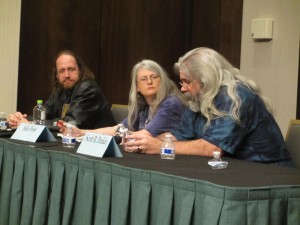 * Nanowrimo is nothin’. It *IS* possible to write a novel (short novel, maybe) in three days. It’s like a Game Jam. It’s only a first draft, and it takes immense discipline and seclusion for a solid three days, requires some pretty solid structure (or even a formula) going in, and you are going to be a wreck by the end of the third day, but it’s doable. Just ask Michael Moorcock. Or L. L. Muir, who gave the presentation.
* Nanowrimo is nothin’. It *IS* possible to write a novel (short novel, maybe) in three days. It’s like a Game Jam. It’s only a first draft, and it takes immense discipline and seclusion for a solid three days, requires some pretty solid structure (or even a formula) going in, and you are going to be a wreck by the end of the third day, but it’s doable. Just ask Michael Moorcock. Or L. L. Muir, who gave the presentation.
* In-between releases, a developer / author / creator should take some time to give back to the community. They should be part of the community, a contributor, not just someone who shows up every few months to say “buy my thing!”
* Focus on your creation / product. Not yourself. It’s not about you, the creator. It’s what you are creating for your audience. Don’t lose sight of that.
* We are entertainers. Our audience doesn’t work for us – it’s the other way around. Focus on making people happy.
* What we do is both an art and a business. We do it for the art, and we create what we create because we have passion for it – and we must. But those who survive and “make it” are almost always the ones who treat it as a business and a career. And, of course, *produce*.
* In writing, don’t worry about nailing the perfect opening sentence or opening chapter. That happens in revision. As often as not, that whole first chapter will just go into the virtual wastebasket anyway when you realize you started too early.
* Your editor is your partner, not your adversary. And most of the time, their suggestions aren’t demands … they are possible solutions to a problem they’ve found. They may be wrong. If that’s the “hill you are ready to die on,” stick to your guns, but pick your battles. But more often than not, rather than digging in you really just need to talk with them and figure out an alternative solution to the problem they are seeing.
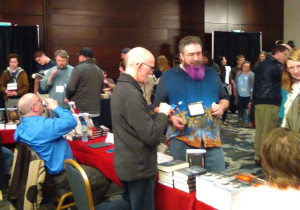 * Genre fiction (and I’d say about all video games) are concept-driven. You should be able to explain your concept in as little as 10 seconds, and maybe a more elaborate version within 60 seconds. If you can’t do that, you’ve got a fundamental problem. But ideally, your concept alone in the 1-3 sentence “elevator pitch” should rock it and capture the listener’s interest all by itself.
* Genre fiction (and I’d say about all video games) are concept-driven. You should be able to explain your concept in as little as 10 seconds, and maybe a more elaborate version within 60 seconds. If you can’t do that, you’ve got a fundamental problem. But ideally, your concept alone in the 1-3 sentence “elevator pitch” should rock it and capture the listener’s interest all by itself.
* READ in your chosen genre. I’d add… PLAY GAMES in your chosen genre. LOTS. Especially the good ones. This helps train your brain to the expectations of the genre.
* Marketing rule-of-thumb: Spend approximately 10% of what you expect to make on marketing. But be honest on those projections.
* Plan your schedule out months in advance. Be professional (and realistic). Include marketing / business activities.
* In the past, warfare and weaponry “force multipliers” were all about increasing damage. In the post-nuclear age, it’s more about accuracy and intelligence: Hitting exactly the right target.
* In the past and future, with humans or human-like beings fighting, warfare will always be about logistics (and fortification).
* Your odds of “making it” as an author (or, I’d suggest, as an indie game developer) are SLIM. But there are things you can do to boost your odds… maybe not putting them in your favor, but increasing your chances to less slim. Combine that with persistence, and you see where the successes are coming from.
* Get help. Ultimately – we can’t do it all. And if we try, we’re taking time away from the things we do well to work on things that we probably don’t. Or maybe really suck at. What’s a better use of our time? And frankly we often simply need another set of eyes or suggestions.
* Shut up and write. Or create.
The thing I saw over and over again was the value of persistence, focus, and constant improvement / refinement of yourself as a creator. In a nutshell, short of blind luck (which does happen), that’s the only way to “make it,” and even that depends on luck… being ready when opportunity comes knocking.
In a similar vein, NETWORKING. It’s easy to believe that since so much of what we do is fairly solitary, that our need for a community is minimal. But if you talk to the pros, the guys and gals who have “made it” to a reasonable level of success, they will talk a lot about it. The whole thing about opportunity knocking? It finds your door through your network. And doubly cool, events like this provide tons of networking opportunities. But of course, calling it “networking” is a formal and businesslike description of what really comes down to meeting or getting to better know a lot of cool people doing cool things and building friendships. That’s intrinsically valuable all by itself, but the business benefits of this are MANY.
As to the whole persistence and productivity thing… 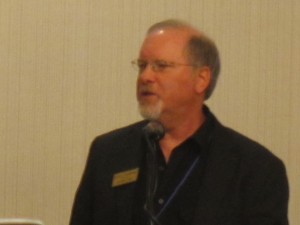 Kevin J. Anderson offered a really great analogy (with respect to writing, but again… I think it was applicable to any creative endeavor). He said there are a couple of ways to make popcorn (well, not including just nuking a bag). First of all, you can take a clean pan, put it on the oven burner, add exactly 1 tablespoon of oil and evenly spread the oil across the entire surface of the pan. You then turn the burner up to get the pan to exactly the right temperature – no more, no less. Then you select the perfect kernel of popcorn from your container of popcorn, and place it in the exact center of the pan where the heat is perfect. Then wait as the ripples form, and then (hopefully) when the kernel pops you immediately remove it to a paper towel to soak up the excess oil. Then you turn off the burner, let the pan cool, and then wash it and clean it so the pan is in pristine condition. Then you repeat the entire process all over again.
Kevin J. Anderson offered a really great analogy (with respect to writing, but again… I think it was applicable to any creative endeavor). He said there are a couple of ways to make popcorn (well, not including just nuking a bag). First of all, you can take a clean pan, put it on the oven burner, add exactly 1 tablespoon of oil and evenly spread the oil across the entire surface of the pan. You then turn the burner up to get the pan to exactly the right temperature – no more, no less. Then you select the perfect kernel of popcorn from your container of popcorn, and place it in the exact center of the pan where the heat is perfect. Then wait as the ripples form, and then (hopefully) when the kernel pops you immediately remove it to a paper towel to soak up the excess oil. Then you turn off the burner, let the pan cool, and then wash it and clean it so the pan is in pristine condition. Then you repeat the entire process all over again.
Or, of course, you can just dump all the popcorn in, not really be able to predict in advance which kernel will pop or which direction it will pop. In the end, you’ll have a whole bowl full of popcorn either way, but in the first case you may starve to death before you get there.
Obviously, he advocates more of a shotgun approach, taking advantage of unpredictable opportunities as they arise.
One more thing about LTUE, which I already knew but was powerfully reinforced this year: The science fiction / fantasy writing community in Utah is incredibly supportive and awesome. I saw it and I experienced it firsthand every day of the symposium. Industry veterans at all levels were willing and even eager to stand and talk with others in their field of any level, offering advice and encouragement. We were cheering on each other’s successes and being really cool when a dummy like me stuck his foot in his mouth. All this in an industry sort of notorious for its introversion. I saw it with the art folks, too, as my daughter had a similar experience with that group. Scott Parkin told me Saturday night that over 12% of the Writers of the Future winners come from Utah, and he believes it is in no small part due to the community and mentorship available here.
Me? I’m definitely signing up for next year. I learned a lot, met a lot of great people, and had an absolute blast.
(Note – some of these photos are courtesy of my good friend, and fellow game-developer-and-author John M. Olsen and his wife.)
Filed Under: Biz, Books, Events - Comments: Read the First Comment
Leveling Up at Life, the Universe, and Everything
Posted by Rampant Coyote on February 12, 2016
I was driving home this evening with Golden Earring’s Radar Love playing on the stereo. I resisted the urge – only barely – to crank it up to eardrum-bleeding levels. I’m not even sure my car stereo goes that high, but it’s the thought that counts, right? It’s the perfect music for driving alone on the freeway late at night. And a dang good way to finish off one helluva day at Life, the Universe, and Everything (LTUE) 2016.
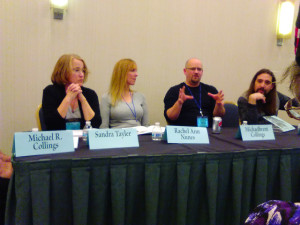 This symposium is very different from, say, Comic Con. I heard people refer to it as a writer’s conference, which it really isn’t, but it probably shares more in common with something like that than a big fan spectacle like Comic Con. The symposium is all about the panels, and while meeting the big famous authors is of course a thing, it’s more about learning from them. At least that seemed to be the case in the panels I attended.
This symposium is very different from, say, Comic Con. I heard people refer to it as a writer’s conference, which it really isn’t, but it probably shares more in common with something like that than a big fan spectacle like Comic Con. The symposium is all about the panels, and while meeting the big famous authors is of course a thing, it’s more about learning from them. At least that seemed to be the case in the panels I attended.
Compared to similar panels at events like Comic Con, these felt different. Events like Comic Con were more like… the real authors talking to total newbs and “aspiring” writers. Still great information, but more geared towards very inexperienced audience. While the content wasn’t very different, and maybe it was more of my own perception, but it did feel like the panelists were willing to get a little less basic, and a little more “down to earth.”
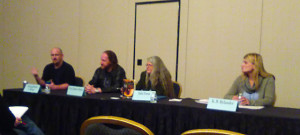 I attended panels on managing a large game project, defining and measuring success, marketing on a minimal budget, selling short stories, and writing action scenes. All of these were pretty dense with useful information, and I filled lots of pages with notes. Panelists at these sessions included Howard and Sandra Tayler, Rachel Ann Nunes, Michael R. Collings, Michaelbrent Collings, Kevin J. Anderson, Alan Bahr, Alexi Vandenberg, Larry Correia, K.B. Rylander, Julie Frost, Eric James Stone, Angela Hartley, Robert Defendi, Michael Glassford, Alyson Peterson, C. Michelle Jefferies, Rebecca Rode, Michelle Argyle, and Peter Orullian. Some of the names may be familiar to you. Others – maybe not. But suffice to say, lots of sharp people who either really know their stuff, or are veterans enough to have learned some hard lessons and were willing to share this information with the rest of the community.
I attended panels on managing a large game project, defining and measuring success, marketing on a minimal budget, selling short stories, and writing action scenes. All of these were pretty dense with useful information, and I filled lots of pages with notes. Panelists at these sessions included Howard and Sandra Tayler, Rachel Ann Nunes, Michael R. Collings, Michaelbrent Collings, Kevin J. Anderson, Alan Bahr, Alexi Vandenberg, Larry Correia, K.B. Rylander, Julie Frost, Eric James Stone, Angela Hartley, Robert Defendi, Michael Glassford, Alyson Peterson, C. Michelle Jefferies, Rebecca Rode, Michelle Argyle, and Peter Orullian. Some of the names may be familiar to you. Others – maybe not. But suffice to say, lots of sharp people who either really know their stuff, or are veterans enough to have learned some hard lessons and were willing to share this information with the rest of the community.
It was amazing. I left not only with a feeling that I’d learned a lot, but with a lot of ideas. Both on the writing side of things, and on the video game development side of things. And all this doesn’t come close to the awesomeness of talking to people between sessions. There are a lot of people at various stages of their geek-awesome careers and pursuits, and some great shared experiences and ideas to capitalize on. Oh, and as per-registered attendees, my wife and I got swag bags including a DVD of the awesome local movie Mythica: A Quest for Heroes. Yeah. That one. I think we have a half-dozen copies of it now, one of them signed by the cast.
As just one note of the coolness of dealing with this local author community: Some time ago I reviewed Craig Nybo’s book, Small Town Monsters. In a nutshell – there were some flaws that had been missed in editing that marred what was an otherwise (and still) a very enjoyable story. The best thing about the book is that it makes werewolves freaking scary. As in, force-of-nature, go-ahead-and-erase-the-town-off-the-map scary. It was unique (at least in my experience) and fun. Today I spoke with him for a few minutes and he mentioned the review and remembered I was the one who gave it (yikes!). He wanted to thank me for the review, and told me that he’d recently revised the book based on my criticisms, fixing as many of those issues that he could find. Not that he wanted me to change my review, only that my comments helped him turn it into a better book, and how awesome was it that as an indie he could actually do that?
Indie. Local. It’s all kinda cool.
After that, my family and I found a burger and “pie shake” (like, dump a slice of pie into a milkshake in the blender) place around the corner for dinner. They were having trouble keeping up with the convention crowds, but the food was good. And I had a milkshake. Because, duh. I couldn’t finish it, though. It was delicious, but it was very rich, and just too much.
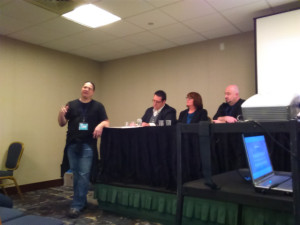 Then came the Sibyl’s Scriptorium awards ceremony. As I understand it, this used to be just an LTUE event, but three years ago they turned it over to Sibyl’s Scriptorium to manage and focus on the event (including – awesomely – releasing a book each year of the final entries). I’d been notified that I’d been a finalist and that I’d placed, but not how I’d placed.
Then came the Sibyl’s Scriptorium awards ceremony. As I understand it, this used to be just an LTUE event, but three years ago they turned it over to Sibyl’s Scriptorium to manage and focus on the event (including – awesomely – releasing a book each year of the final entries). I’d been notified that I’d been a finalist and that I’d placed, but not how I’d placed.
The awards were for poetry, art, and short stories, including adult and school-age categories. The ceremony was presented by some of the “Space Balrogs,” with Peter Orullian giving a keynote address. His address was one a encouragement, engaging the audience and finalists with questions and soliciting their comments and ideas.
My submission had been an idea that had been bouncing around my head for years about a modern-day genie dealing with… well, modern-day problems, and a magical power that was a bit more subtle than traditionally represented. I’d originally written it for an open anthology submission, and its rejection disappointed me. After all, I’d had this idea for years! However, I’d received some notes on its rejection, and figured I could use these to take a few hours to revise the story. The few turned into many, and the revised story was much stronger than its original incarnation.
It won first place in the adult short story competition.
No, it’s not the Writers of the Future contest or anything. But in spite of convincing myself all month that it was no big deal – readying myself for disappointment again, I guess – in the end, it felt like a real accomplishment. As I was leaving, I ran into Rachelle Funk, the chief editor, and she told me how much she loved my story, “Best Wishes.” Talk about feeling ten feet tall! And talk about the value of persistence, a factor that was repeated by the vets many times during multiple panels today.
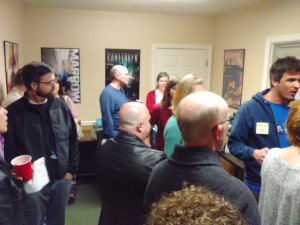 Afterwards, a bunch of people went to an “LTUE After Party” held in the offices of a local publisher (Future House). It was also a launch party for their novel just released today, Guardians, second in the Caretaker Chronicles. They had root beer floats which I couldn’t handle after the milkshake earlier that night, but it was a packed space with lots of great conversation. I bought a copy of the original book, Caretaker, and had the author, Josi Russell, sign it and spoke with her for a while. I spoke with a lot of people. The big news throughout the evening were the sales of the original book and the sequel on Amazon with the big launch event and sale. And honestly, the sales numbers for a single day were probably more than any of the anthologies I’m in ever sold in total. But it was impossible not to share the excitement of a fellow local author having a really good day.
Afterwards, a bunch of people went to an “LTUE After Party” held in the offices of a local publisher (Future House). It was also a launch party for their novel just released today, Guardians, second in the Caretaker Chronicles. They had root beer floats which I couldn’t handle after the milkshake earlier that night, but it was a packed space with lots of great conversation. I bought a copy of the original book, Caretaker, and had the author, Josi Russell, sign it and spoke with her for a while. I spoke with a lot of people. The big news throughout the evening were the sales of the original book and the sequel on Amazon with the big launch event and sale. And honestly, the sales numbers for a single day were probably more than any of the anthologies I’m in ever sold in total. But it was impossible not to share the excitement of a fellow local author having a really good day.
After all, I was too. It had been a really, really good day.
Now, as I’m getting ready to start day 2, I feel like I’ve “leveled up” a little. I feel like I’m understanding things a little better. I gained some new ideas for not only improving my writing, but also my game development. I won an award. I was published in another anthology. I made some new contacts. I feel a little less like a rank amateur and… well, more like something slightly less rank. I feel more of a part of the speculative fiction writing community – which, from what I can tell and what I’ve heard – is pretty dang awesome and supportive here in Utah.
It’s just been a pretty dang good day.
Filed Under: Books, Events - Comments: 3 Comments to Read
What We Can Learn From Doom
Posted by Rampant Coyote on February 11, 2016
Relatively short, sweet, and good for making you think – what gameplay lessons can we learn from Doom:
Now I don’t know about the magic number 7 (and after all, Doom 2 increased the bad guy count anyway), but I think this guy nails the basics of it.
I remember a criticism of an early D&D 3.0 compatible 3rd party monster book… that too many monsters were just “claw / claw / bite” – in other words, conventional attacks, with very little interesting about them from a stats and gameplay perspective. Why bother? That’s just a bigger / tougher / harder-hitting straight-up fight that gets pretty old by level 2. Sure, occasionally, it’s fun to just deal with a vanilla enemy (gameplay-wise), when it is uncommon enough to constitute variety.
Later books by the same editors took this criticism to heart, and the bulk of the creatures possessed interesting abilities which, if they were able to get them into play, forced players to adapt their strategies. Mixing and matching enemies of complimentary abilities can be a little difficult if you are trying to maintain some semblance of feasibility to your world … a problem Doom didn’t have. And the behaviors and attributes weren’t always simple. But ultimately, it was the same idea… an orthogonal differentiation of enemies.
The other factor that Doom capitalized on – and Doom 2 did an even better job – was combining this with level design to make combats even more interesting and requiring the player to adapt even more. It’s one thing to walk into a giant room full of bad guys and try to intelligently circle-strafe, but it’s something else entirely if the terrain puts the enemies behind cover or surrounded by moats of nuclear waste or something along those lines which require the player to change things up even more.
Another important point not to be lost here: I think a lot of this happened *because* Doom was, fundamentally, so simple and straightforward. It required the designers to shuffle things around a lot and to invent clever ways of making the level design, monster design, and interactive elements of the level all work together to create challenges that were greater than the sum of the parts.
Anyway – worth checking out!
Filed Under: Design - Comments: 2 Comments to Read

